
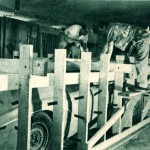
Caption: Construction work in progress includes elaborate wooden framework used by workmen to get at body from all angles.
Hi Gang…
Did you know concept cars back in the 1950’s were made out of fiberglass???
Egads! How could such a thing happen!!! Who do we need to speak with? Well…..you better speak with a whole bunch of people because starting with the 1941 Ford Soybean car, there was a litany of splendid, innovative, important and what are now are incredibly valuable concept cars.
And “concept cars” by our current definition were built by major manufacturers, independent coachbuilders, famous industrial designers, and even a few of our fabulous fiberglass folks like Noel Bangert who designed the Manta Ray (inspired by a concept car, no less).
Some of the famous concept cars of the ‘50s built in fiberglass include the Buick Wildcat I and II, Cadillac LeMans, Oldsmobile F88, Plymouth Belmont, Packard Panther, Dodge Granada, Oldsmobile Golden Rocket, and a host of other fiberglass concept cars that would take your breath away. And there are many more concept cars made of fiberglass to share gang…… far more than you might realize.
If it was special, innovative, stylish, and modern – it was made of the new wonder material “fiberglass” – and it was valuable too!
Today’s story opens up a new category of cars that we’ll be featuring here on Forgotten Fiberglass – “Fiberglass Concept Cars” And to some of you, this may be the most interesting category of cars we’ve covered yet.
Let’s get down to work and start our review of one gorgeous and innovative concept car built from fiberglass – the 1955 Bill Flajole “Forerunner.”
The Flajole Forerunner: Road & Track, October 1955
The Pseudo Convertible Becomes Honest
Story by John Bond
Photography: Robert F. MacKenzie
Prominent in the U.S. ad-man’s vocabulary of misleading terms is that masterpiece of contradictory phraseology, “hardtop convertible,” intended to designate a body style which does not convert at all. Hard top, closed bodies having convertible body type doors and window frames are not new, of course.
Hudson’s semi-custom line of bodies had this in 1928 and Mercury offered a club coupe with disappearing chrome window frames in 1939. Attempts to develop a really practical convertible have been made throughout the years. As early as 1922, Mr. B.B. Ellerbeck of Washington D.C., shows a true hardtop design on a Stutz Bearcat chassis.
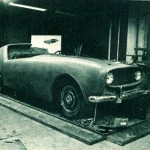
Caption: Half finished body shell rests on a Jaguar chassis. At least 7000 man hours were spent on the Forerunner project.
On this model, large steel struts on each side of the body acted together as pivoting levers to hoist the solid top into a position over the rear trunk locker. Peugeot showed a coupe with a metal top which slid back and under the trunk-lid, at the Paris show in 1938.
Chrysler’s 1941 Thunderbolt had a neat one-piece metal top which hinged back into the truck space. In the post-war field, the ill-fated Buffalo project, the Playboy, had a two-piece jointed metal roof which disappeared behind the seats, a design similar to one patented by Motor State Products Company of Ypsilanti, Michigan, in 1945.
The Forerunner shown here is no showroom display car. It was designed and built by Wiliam Flajole and his staff at the firm’s styling studio in Detroit. Mr. Flajole is advanced styling consultant to American Motors and like most stylists he likes sports cars. (One of his earlier designs was a re-modeled Nash-Healey built for Ted Williams).
Mounted on a modified Jaguar XK-120 chassis, the Forerunner has a retractable roof feature which is unique and was actually first conceived in 1952. The body of this car is all fiberglass and the construction work took 7000 man-hours. An interesting detail is the fact that the female plaster molds were taken off the full size clay model, rather than the usual process of making up a plaster form for a master.
There is no intention of building any duplicates of this car which has been constructed purely as a design exercise to show certain styling features which Mr. Flajole and his associates believe to be interesting.
The unusually high rear takes some getting used to, but is perhaps a further development of the headrest as now used by Ferrari and Mercedes. The sliding roof section is made of ¼ inch Plexiglass to a new specification known as “30% transmission green” – opaque to ultra-violet and infra-red rays.
It slides on nylon rollers and though easily operated by hand, there is a push-button controlled electric motor for power operation. One question which is sure to be raised is whether this car actually qualifies as a convertible. If it does, then the normal sliding roof of many British and German sedans makes them convertibles, too – if we relax the definition another step. It also seems doubtful if the complete lack of backward visibility will meet with approval by sports car technical inspectors, if the Forerunner should ever appear in competition.
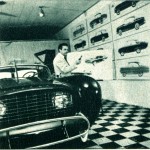
Caption: Designer Flajole, at work in his Detroit studio, stands beside the completed Forerunner and indicates a wall covered with sketches of new ideas in advanced styling.
The very high seat backs are of course a useful feature, taken from aeroplanes and buses, but there is some apprehension that a headrest for the driver is a very dangerous fitment. The light bumpers (10 lbs., each) seem barely adequate and show no correlation with the general styling theme, but body contours are well done, and interest is sculptured into the lines rather than tacked on as decoration.
Claimed to be capable of over 140 mph and to weigh only 2100 lbs. (the Jaguar chassis alone weighs that much!), the Forerunner is at least a “nice try.” Someone may yet come up with a real hard top convertible that is practical and looks like an open sports car when the top is down. JB.
Summary:
“The construction work took 7000 hours???” Wow! At $50 bucks an hour that’s going on a half-million dollars in modern dollars to construct this one-off fiberglass cars. You know….most of our fiberglass cars took about 2000 hours to build which is only $100,000 in modern dollars for the labor – a considerable bargain by any measure 🙂
I’m pleased to say that the Flajole Forerunner still exists today, and in fact was recently shown at the Amelia Island Concours d’ Elegance with great success. More about this beautiful car in future stories here at Forgotten Fiberglass.
Hope you enjoyed the story, and until next time…
Glass on gang…
Geoff
——————————————————————-
Click on the Images Below to View Larger Pictures
——————————————————————
- Caption: Designer Flajole, at work in his Detroit studio, stands beside the completed Forerunner and indicates a wall covered
- Caption: Construction work in progress includes elaborate wooden framework used by workmen to get at body from all angles.
- Caption: Half finished body shell rests on a Jaguar chassis. At least 7000 man hours were spent on the Forerunner project.
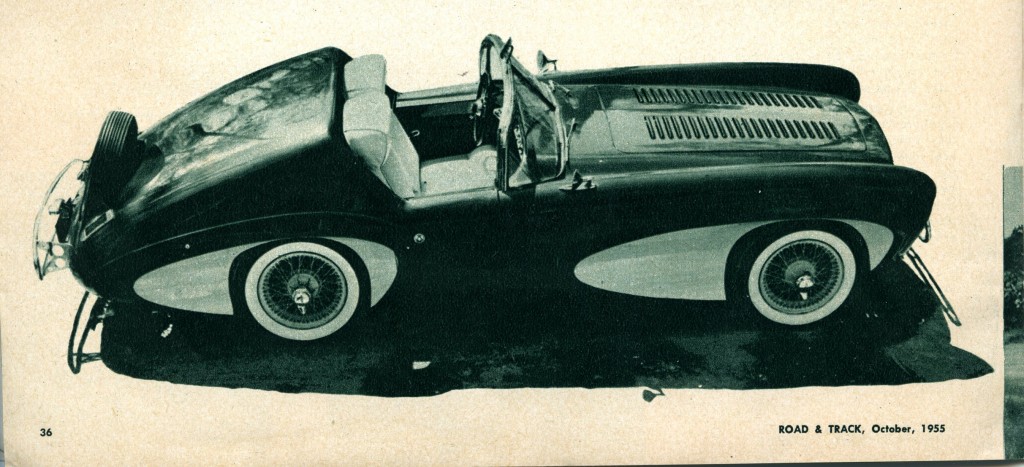

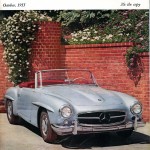
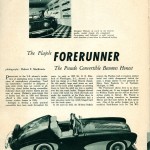
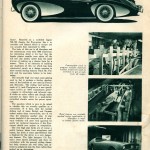
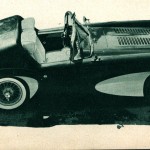
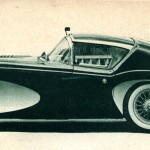
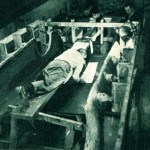

For those interested in a further update, this car will be taking up residence at the Hershey AACA Museum in Hershey, Pennsylvania as of October 2012 and will be available for the public to view.
Bill Flajole is perhaps more famously known as the prototype designer for the Nash Metropolitan. (I videotaped the only known interview with him before he died in 1998. Chit!)
His daughter Diana Hawkinson still has a bunch of the publicity photos that Flajole took of the car. Plus, she has the story of her dad taking her to the grocery in that car and turning every head in the lot.
This car landed in the hands of diet guru Jenny Craig’s husband until it was sold recently. (To whom, I don’t know.)
A fascinating and finely crafted car that many others have nevertheless called hideously ugly. (Sorry to seem sacrilegious. Opinions on the styling vary quite widely. I think it’s kinda cool.)
Geoff, if you want, I can put you in contact with Diana. She’s very accessible and always happy to talk about her dad’s work.
—-Todd Ruel
Saw this amazing car at Pebble Beach some years ago, what a fine automobile… truly rolling drive able art.